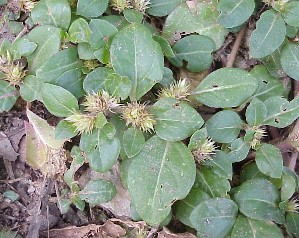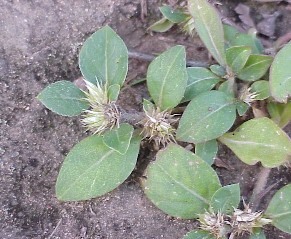Scientific name: Alternanthera pungens Kunth.
Synonyms: Achyranthes repens L.; Alternanthera achyrantha R.Br.; Alternanthera echinate Sm.; Alternanthera repens (L.) Link.Common names: Khaki WeedFamily: AmaranthaceaeOrigin:Native of South America. Habit:A prostrate, herbaceous perennial. Habitat:A weed of disturbed or tended areas (eg. roadsides, parks, lawns, etc.). General description:Stems and leavesProstrate stems are produced from a central crown. They have a reddish appearance and often take root at the nodes (produce adventitious roots). There are short, soft hairs on the stems and sometimes on the leaf stalks (petioles). The leaf blades are obovate (egg-shaped) or elliptic in shape (8-60 x 8-60 mm in size). The paired (oppositely arranged) leaves differ in size (ie. one leaf of the pair is significantly larger than its partner) and the leaf margins are somewhat wavy. Flowers and fruitThe small flowers are grouped together on spikes 8-12 mm long and 6-10 mm wide. The 'petals' (perianth segments) are whitish or straw coloured, 5-7 mm long, with a sharp point at the tip. Barbed hairs are found at the base of the perianth segments. These segments become hardened as they age and form prickles. Flowering occurs from spring to autumn. The fruit is a prickly burr, about 1 cm long, with a truncate apex. Distinguishing characteristics:This plant grows very close to the ground (prostrate) and has quite prominent prickles (formed from hardened perianth segments). Soliva pterosperma (bindy eye) is another prostrate weed that produces prickles. However, this species has very different, highly divided, leaves. Lesser joyweed (Alternanthera denticulata) and hairy joyweed (Alternanthera nana) are also prostrate and have similar flower clusters, but neither of these species produce prickles. Noxious status:Declared in Victoria, New South Wales, South Australia and the Northern Territory. Also prohibited entry into Western Australia. Sources:Anonymous. Noxious Weed List for Australian States and Territories. (2000). National Weeds Strategy Executive Committee, Launceston. Kleinschmidt, H.E., Holland, A. and Simpson, P. (1996). Suburban Weeds. 3rd Edition. Department of Primary Industries, Brisbane. Parsons, W.T. and Cuthbertson, E.G. (1992). Noxious Weeds of Australia. Inkata Press, Melbourne. Stanley, T.E. and Ross, E.M. (1983-1989). Flora of South-eastern Queensland. Volume 1. Department of Primary Industries, Brisbane. |
Brisbane
St Lucia, QLD 4072
+61 7 3365 1111
© 2009 The University of Queensland



